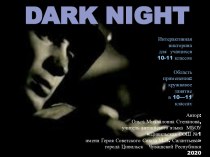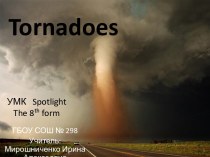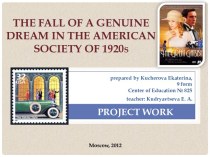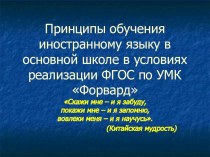- Главная
- Разное
- Бизнес и предпринимательство
- Образование
- Развлечения
- Государство
- Спорт
- Графика
- Культурология
- Еда и кулинария
- Лингвистика
- Религиоведение
- Черчение
- Физкультура
- ИЗО
- Психология
- Социология
- Английский язык
- Астрономия
- Алгебра
- Биология
- География
- Геометрия
- Детские презентации
- Информатика
- История
- Литература
- Маркетинг
- Математика
- Медицина
- Менеджмент
- Музыка
- МХК
- Немецкий язык
- ОБЖ
- Обществознание
- Окружающий мир
- Педагогика
- Русский язык
- Технология
- Физика
- Философия
- Химия
- Шаблоны, картинки для презентаций
- Экология
- Экономика
- Юриспруденция
Что такое findslide.org?
FindSlide.org - это сайт презентаций, докладов, шаблонов в формате PowerPoint.
Обратная связь
Email: Нажмите что бы посмотреть
Презентация на тему American Cinema
Содержание
- 2. OutlineIntroductionPart I. History of the “Industry”Part II. The actors and directorsPart III. Hollywood and the OscarsConclusionReferences
- 4. IntroductionUntil World War I, France was considered
- 6. Part I. History of the “Industry”Legendary American
- 7. Part I. History of the “Industry”In the
- 9. Part I. History of the “Industry”In 1941
- 10. Part I. History of the “Industry”George Lucas’s
- 11. Part II. The actors and directorsAction starsTom
- 13. Part II. The actors and directorsGreat American
- 15. Part III. Hollywood and the OscarsHollywood, district
- 17. ConclusionPopular blockbuster films, enhanced by computer graphic
- 19. Referenceshttp://us.imdb.com/RTO/2003/Oscarshttp://us.imdb.com/Title?0120903http://encarta.msn.com/encnet/refpages/RefArticle.aspx?refid=761567568&pn=2http://us.imdb.com/Sections/Awards/Academy_Awards_USA/awards_summaryhttp://www.imdb.com/Charts/worldtopmovieshttp://www.filmsite.org
- 21. Скачать презентацию
- 22. Похожие презентации
OutlineIntroductionPart I. History of the “Industry”Part II. The actors and directorsPart III. Hollywood and the OscarsConclusionReferences

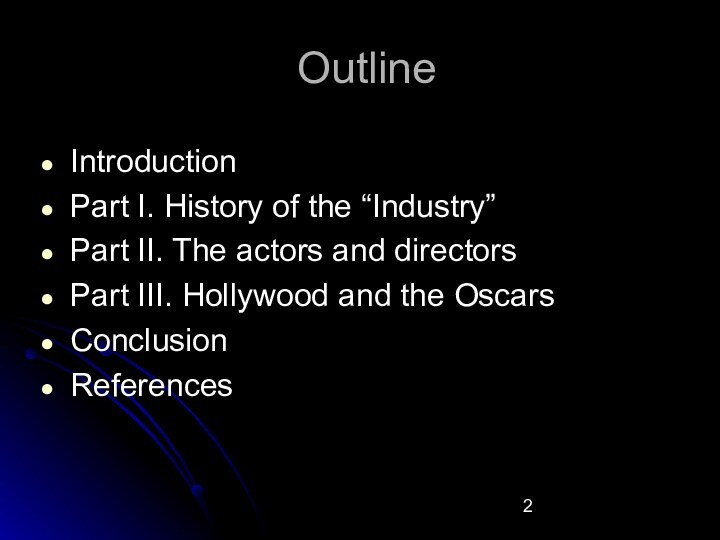
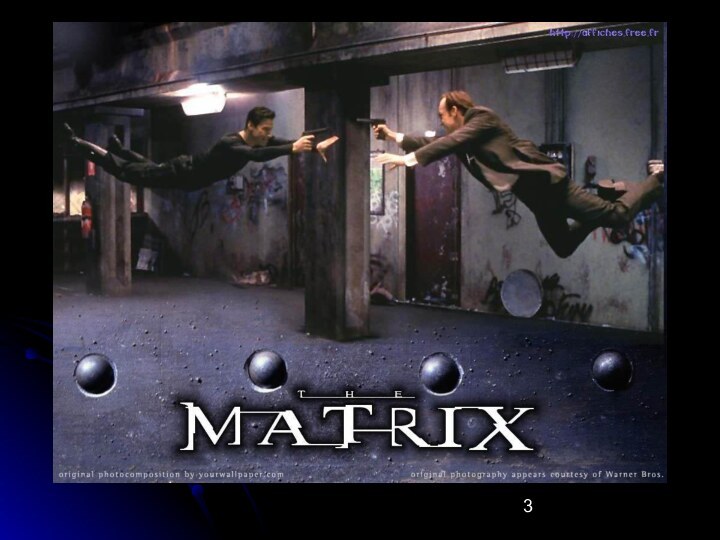
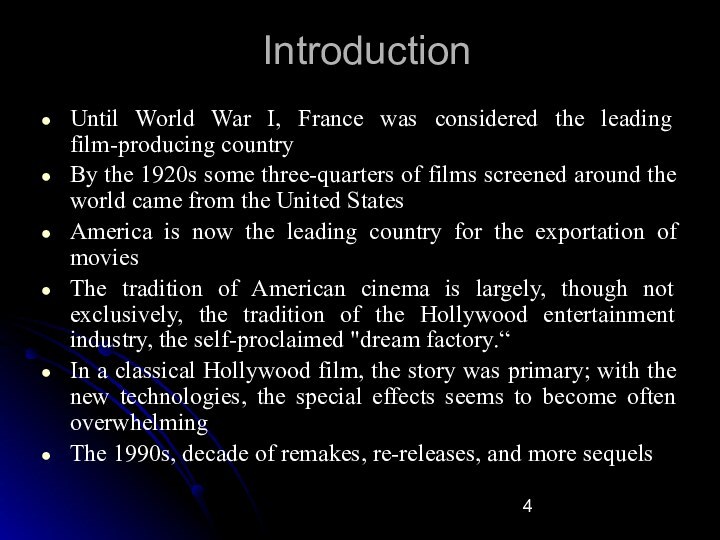
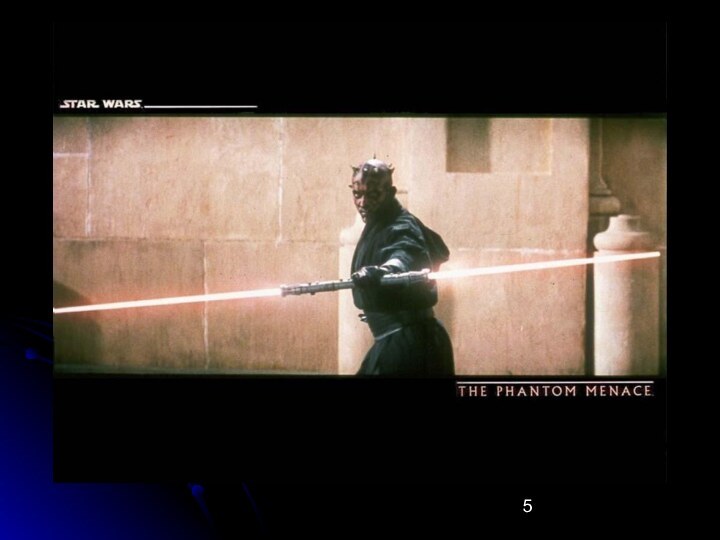
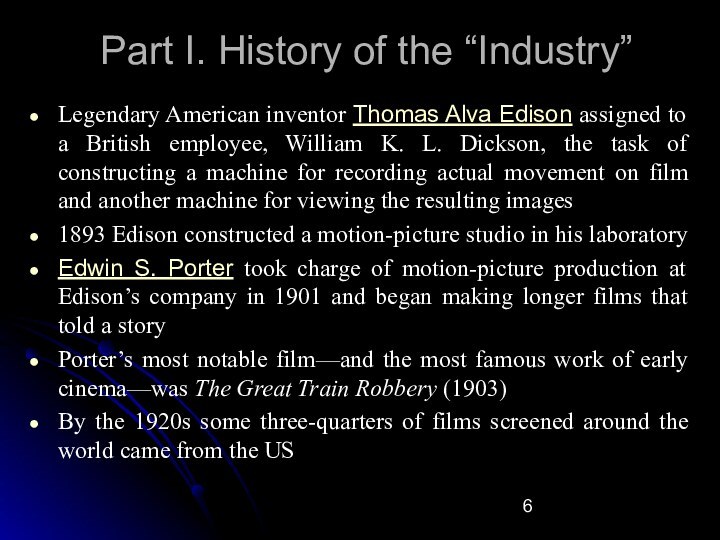
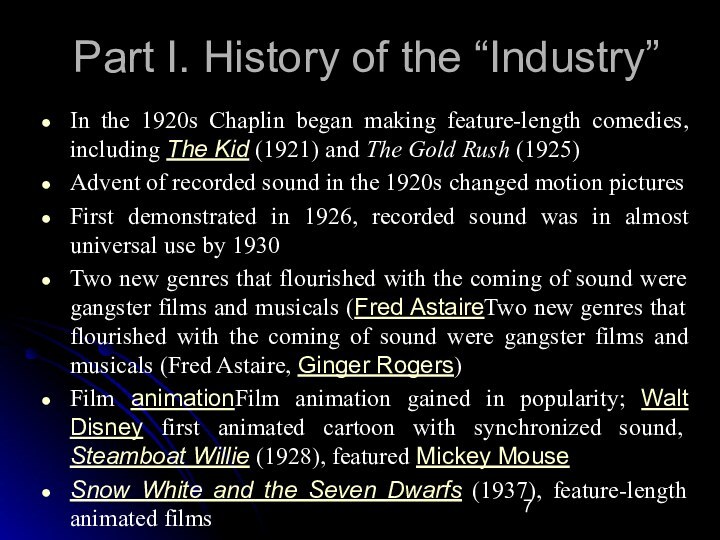
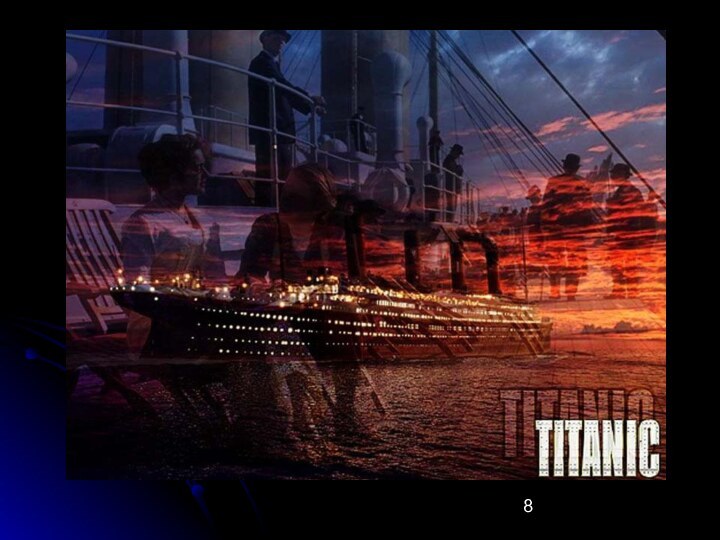
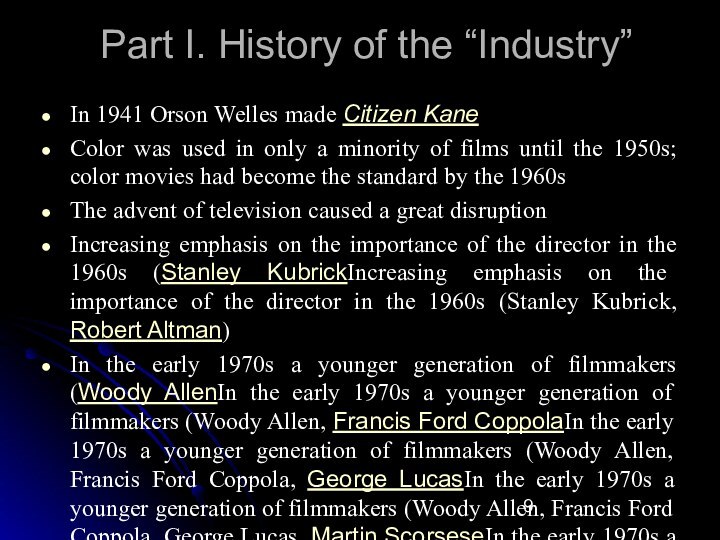
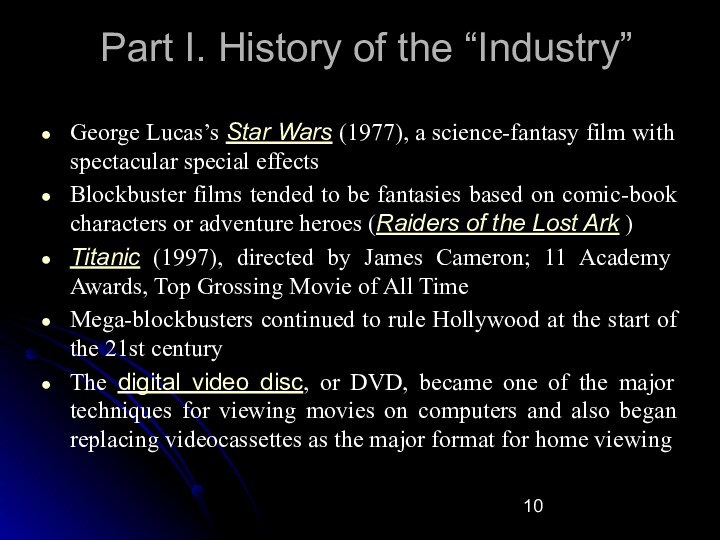
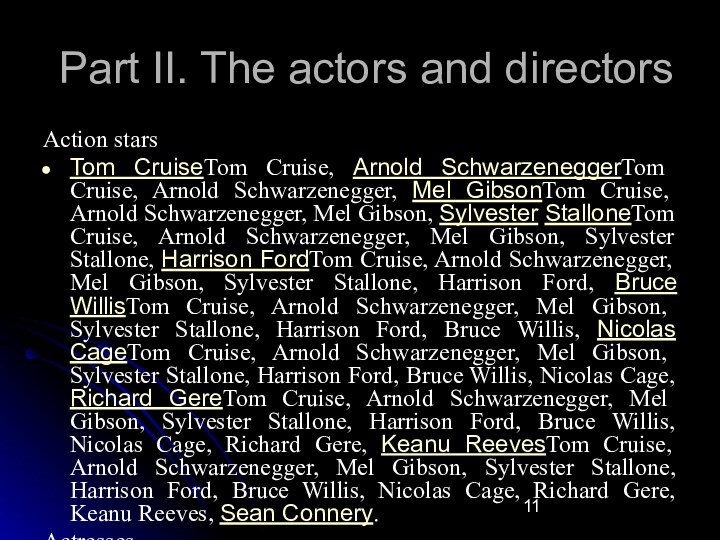
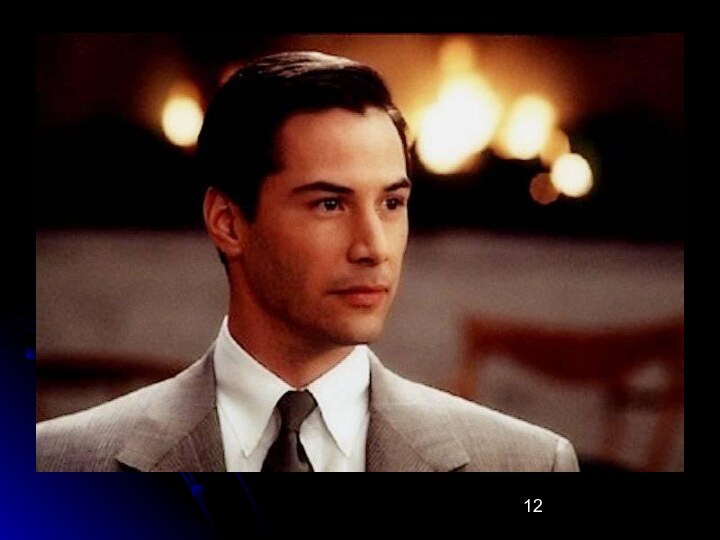
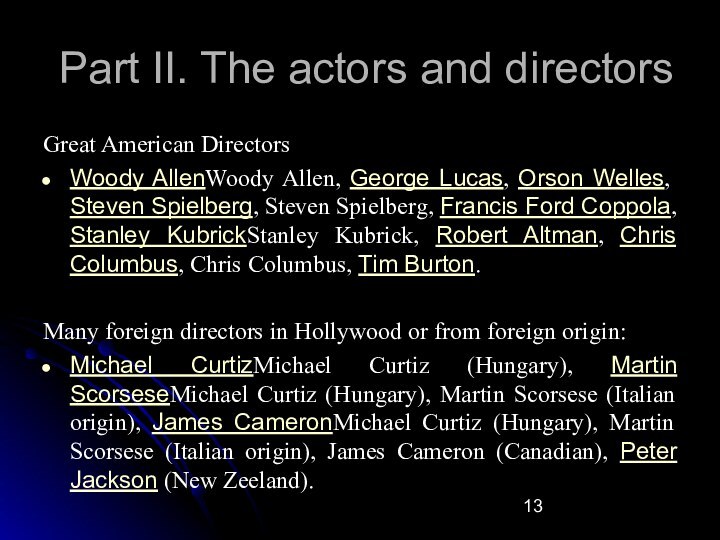
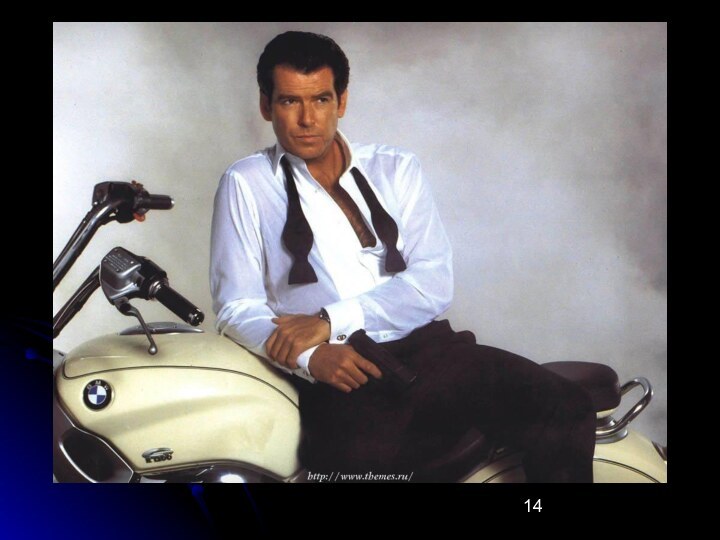
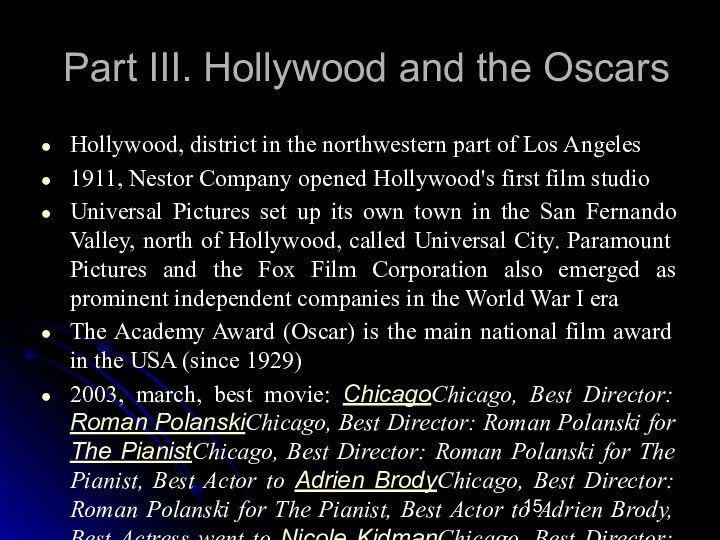
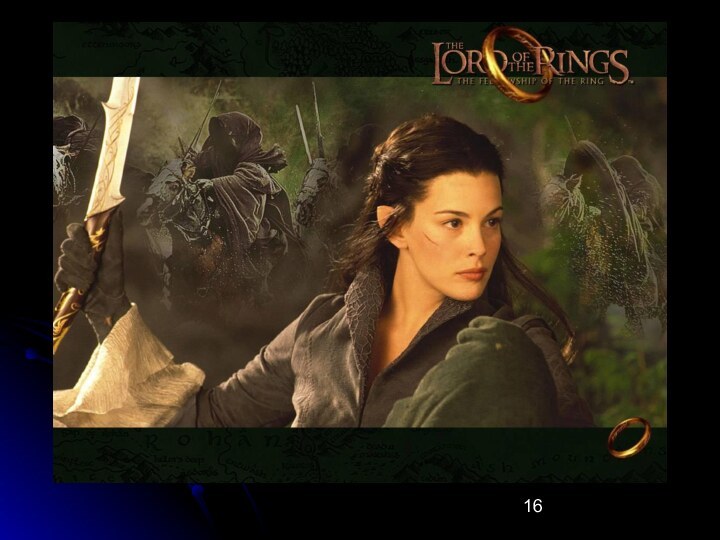
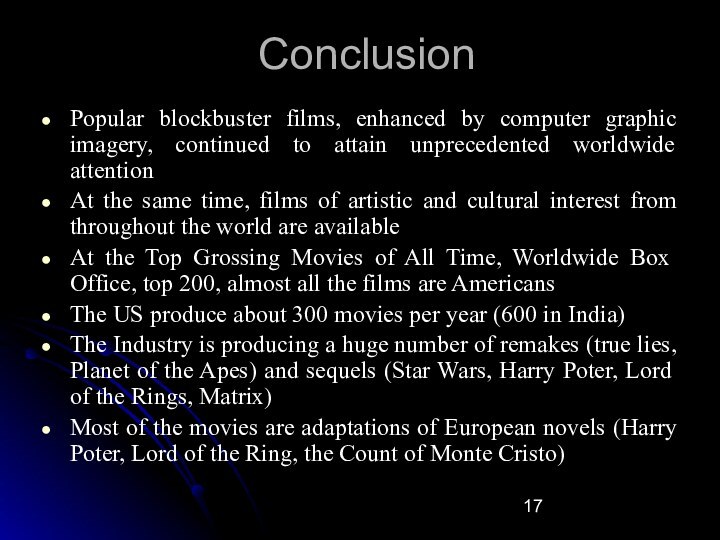
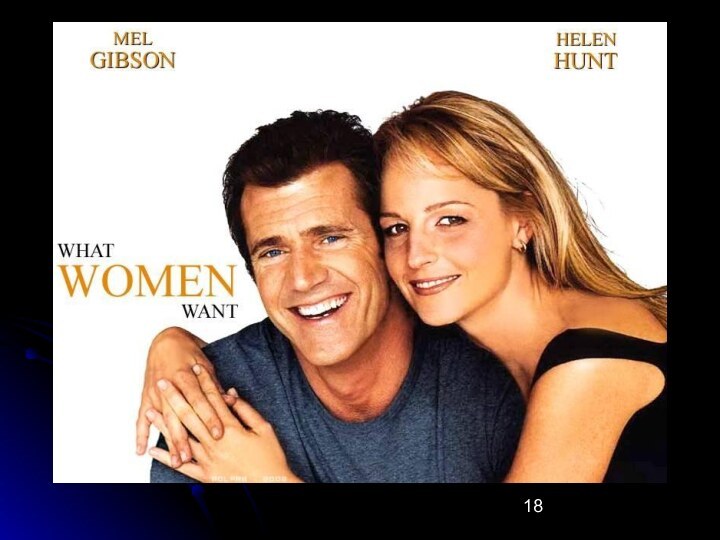
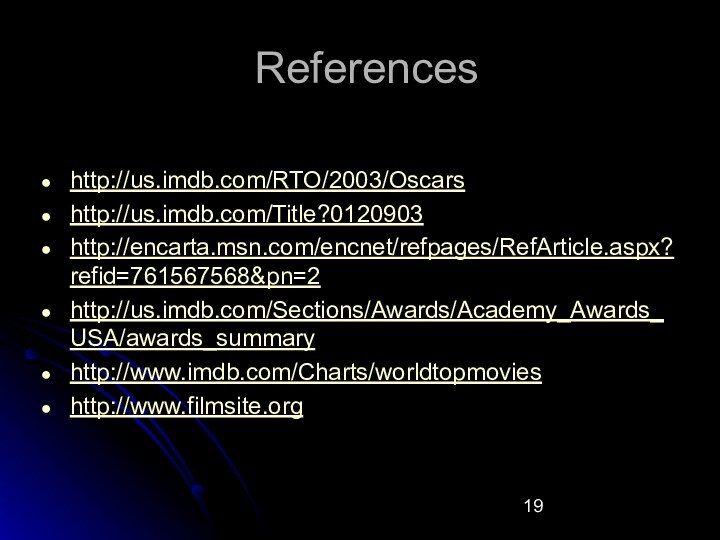
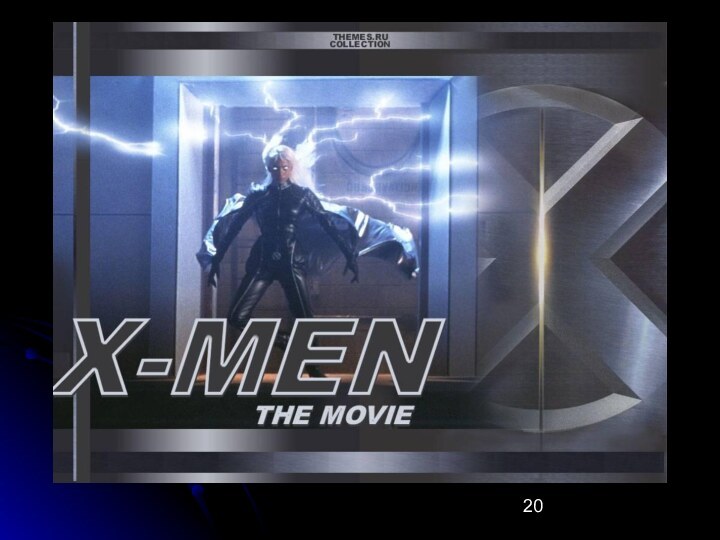
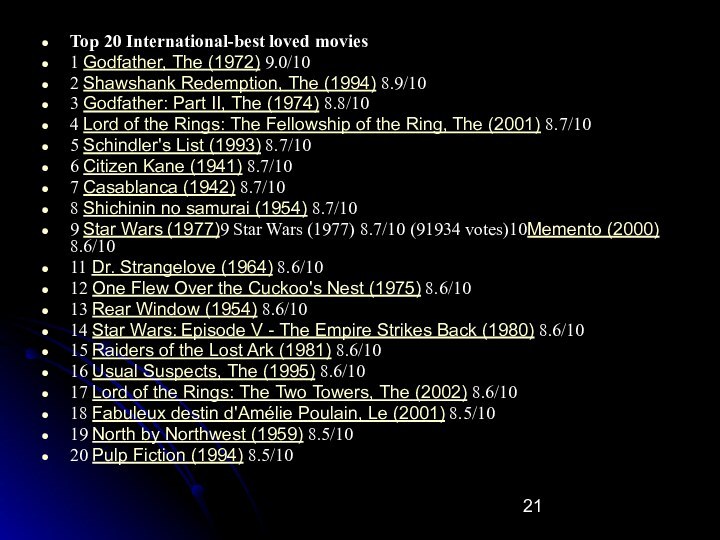
Слайд 4
Introduction
Until World War I, France was considered the
leading film-producing country
By the 1920s some three-quarters of films
screened around the world came from the United StatesAmerica is now the leading country for the exportation of movies
The tradition of American cinema is largely, though not exclusively, the tradition of the Hollywood entertainment industry, the self-proclaimed "dream factory.“
In a classical Hollywood film, the story was primary; with the new technologies, the special effects seems to become often overwhelming
The 1990s, decade of remakes, re-releases, and more sequels
Слайд 6
Part I. History of the “Industry”
Legendary American inventor
Thomas Alva Edison assigned to a British employee, William
K. L. Dickson, the task of constructing a machine for recording actual movement on film and another machine for viewing the resulting images1893 Edison constructed a motion-picture studio in his laboratory
Edwin S. Porter took charge of motion-picture production at Edison’s company in 1901 and began making longer films that told a story
Porter’s most notable film—and the most famous work of early cinema—was The Great Train Robbery (1903)
By the 1920s some three-quarters of films screened around the world came from the US
Слайд 7
Part I. History of the “Industry”
In the 1920s
Chaplin began making feature-length comedies, including The Kid (1921)
and The Gold Rush (1925)Advent of recorded sound in the 1920s changed motion pictures
First demonstrated in 1926, recorded sound was in almost universal use by 1930
Two new genres that flourished with the coming of sound were gangster films and musicals (Fred AstaireTwo new genres that flourished with the coming of sound were gangster films and musicals (Fred Astaire, Ginger Rogers)
Film animationFilm animation gained in popularity; Walt Disney first animated cartoon with synchronized sound, Steamboat Willie (1928), featured Mickey Mouse
Snow White and the Seven Dwarfs (1937), feature-length animated films
Слайд 9
Part I. History of the “Industry”
In 1941 Orson
Welles made Citizen Kane
Color was used in only a
minority of films until the 1950s; color movies had become the standard by the 1960sThe advent of television caused a great disruption
Increasing emphasis on the importance of the director in the 1960s (Stanley KubrickIncreasing emphasis on the importance of the director in the 1960s (Stanley Kubrick, Robert Altman)
In the early 1970s a younger generation of filmmakers (Woody AllenIn the early 1970s a younger generation of filmmakers (Woody Allen, Francis Ford CoppolaIn the early 1970s a younger generation of filmmakers (Woody Allen, Francis Ford Coppola, George LucasIn the early 1970s a younger generation of filmmakers (Woody Allen, Francis Ford Coppola, George Lucas, Martin ScorseseIn the early 1970s a younger generation of filmmakers (Woody Allen, Francis Ford Coppola, George Lucas, Martin Scorsese, and Steven Spielberg)
Jaws marked the turning point in the fortunes of the American film industry, rewriting the blockbuster formula (first film to earn more than $100 million for its studio)
Слайд 10
Part I. History of the “Industry”
George Lucas’s Star
Wars (1977), a science-fantasy film with spectacular special effects
Blockbuster
films tended to be fantasies based on comic-book characters or adventure heroes (Raiders of the Lost Ark )Titanic (1997), directed by James Cameron; 11 Academy Awards, Top Grossing Movie of All Time
Mega-blockbusters continued to rule Hollywood at the start of the 21st century
The digital video disc, or DVD, became one of the major techniques for viewing movies on computers and also began replacing videocassettes as the major format for home viewing
Слайд 11
Part II. The actors and directors
Action stars
Tom CruiseTom
Cruise, Arnold SchwarzeneggerTom Cruise, Arnold Schwarzenegger, Mel GibsonTom Cruise,
Arnold Schwarzenegger, Mel Gibson, Sylvester StalloneTom Cruise, Arnold Schwarzenegger, Mel Gibson, Sylvester Stallone, Harrison FordTom Cruise, Arnold Schwarzenegger, Mel Gibson, Sylvester Stallone, Harrison Ford, Bruce WillisTom Cruise, Arnold Schwarzenegger, Mel Gibson, Sylvester Stallone, Harrison Ford, Bruce Willis, Nicolas CageTom Cruise, Arnold Schwarzenegger, Mel Gibson, Sylvester Stallone, Harrison Ford, Bruce Willis, Nicolas Cage, Richard GereTom Cruise, Arnold Schwarzenegger, Mel Gibson, Sylvester Stallone, Harrison Ford, Bruce Willis, Nicolas Cage, Richard Gere, Keanu ReevesTom Cruise, Arnold Schwarzenegger, Mel Gibson, Sylvester Stallone, Harrison Ford, Bruce Willis, Nicolas Cage, Richard Gere, Keanu Reeves, Sean Connery.Actresses
Halle BerryHalle Berry, Julia RobertsHalle Berry, Julia Roberts, Catherine Zeta-JonesHalle Berry, Julia Roberts, Catherine Zeta-Jones, Renée ZellwegerHalle Berry, Julia Roberts, Catherine Zeta-Jones, Renée Zellweger, Michelle PfeifferHalle Berry, Julia Roberts, Catherine Zeta-Jones, Renée Zellweger, Michelle Pfeiffer, Cameron Diaz.
The Hollywood villains
John MalkovichJohn Malkovich, Billy ZaneJohn Malkovich, Billy Zane, Gary OldmanJohn Malkovich, Billy Zane, Gary Oldman, Jeremy IronsJohn Malkovich, Billy Zane, Gary Oldman, Jeremy Irons, Al PacinoJohn Malkovich, Billy Zane, Gary Oldman, Jeremy Irons, Al Pacino, Rugter Hauer.
Black actors
Samuel L. JacksonSamuel L. Jackson, Michael Clarke DuncanSamuel L. Jackson, Michael Clarke Duncan, Sidney PoitierSamuel L. Jackson, Michael Clarke Duncan, Sidney Poitier, Denzel Washington.
Слайд 13
Part II. The actors and directors
Great American Directors
Woody
AllenWoody Allen, George Lucas, Orson Welles, Steven Spielberg, Steven
Spielberg, Francis Ford Coppola, Stanley KubrickStanley Kubrick, Robert Altman, Chris Columbus, Chris Columbus, Tim Burton.Many foreign directors in Hollywood or from foreign origin:
Michael CurtizMichael Curtiz (Hungary), Martin ScorseseMichael Curtiz (Hungary), Martin Scorsese (Italian origin), James CameronMichael Curtiz (Hungary), Martin Scorsese (Italian origin), James Cameron (Canadian), Peter Jackson (New Zeeland).
Слайд 15
Part III. Hollywood and the Oscars
Hollywood, district in
the northwestern part of Los Angeles
1911, Nestor Company opened
Hollywood's first film studioUniversal Pictures set up its own town in the San Fernando Valley, north of Hollywood, called Universal City. Paramount Pictures and the Fox Film Corporation also emerged as prominent independent companies in the World War I era
The Academy Award (Oscar) is the main national film award in the USA (since 1929)
2003, march, best movie: ChicagoChicago, Best Director: Roman PolanskiChicago, Best Director: Roman Polanski for The PianistChicago, Best Director: Roman Polanski for The Pianist, Best Actor to Adrien BrodyChicago, Best Director: Roman Polanski for The Pianist, Best Actor to Adrien Brody, Best Actress went to Nicole KidmanChicago, Best Director: Roman Polanski for The Pianist, Best Actor to Adrien Brody, Best Actress went to Nicole Kidman for The Hours
Слайд 17
Conclusion
Popular blockbuster films, enhanced by computer graphic imagery,
continued to attain unprecedented worldwide attention
At the same time,
films of artistic and cultural interest from throughout the world are availableAt the Top Grossing Movies of All Time, Worldwide Box Office, top 200, almost all the films are Americans
The US produce about 300 movies per year (600 in India)
The Industry is producing a huge number of remakes (true lies, Planet of the Apes) and sequels (Star Wars, Harry Poter, Lord of the Rings, Matrix)
Most of the movies are adaptations of European novels (Harry Poter, Lord of the Ring, the Count of Monte Cristo)



